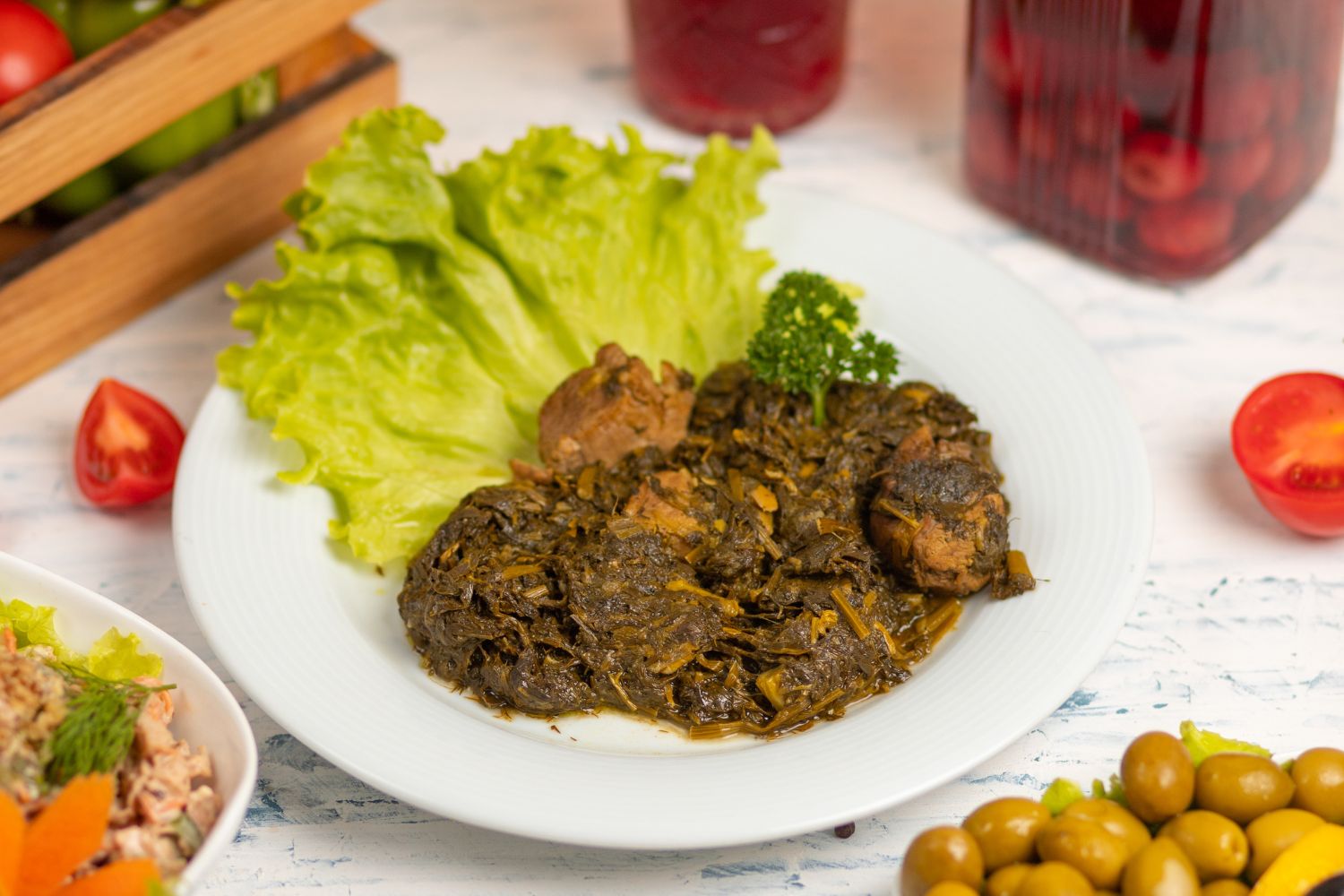Table of Contents
Embarking on a culinary journey through Turkmenistan unveils a captivating tapestry of flavors and cultural heritage. The food from Turkmenistan, influenced by Persian, Russian, Central Asian, and Middle Eastern traditions, offers a delightful fusion of tastes. From beloved traditional dishes to tantalizing street cuisine, Turkmen food is a treasure trove of mouthwatering delights that showcase the richness of its food culture. Let’s dive into this diverse and vibrant world of the food culture of Turkmenistan.
Top Ingredients of the Food of Turkmenistan
In the food of Turkmenistan, a rich tapestry of flavors is crafted through the skillful combination of various ingredients. Here is a list of the most commonly used ingredients that form the foundation of Turkmen culinary traditions:
Rice: A fundamental element in Turkmen cuisine, rice is often served with various dishes and can be prepared in different ways, such as Gyozmak (steamed white rice) or Shavlya (rice cooked with meat and vegetables).
Lamb: Lamb is the preferred meat in Turkmenistan and plays a central role in many traditional dishes like Kebabs, Geperek, and Dimlama.
Spices: Turkmen cuisine features an array of aromatic spices, including cumin, coriander, cardamom, turmeric, and saffron, which infuse depth and flavor into their culinary creations.
Yogurt: Yogurt is an indispensable component of Turkmen cuisine and is used as a sauce (Chaka), a refreshing drink (Dough), or as a marinade for meat.
Onions and Garlic: These two ingredients serve as the base for numerous Turkmen dishes, offering a savory foundation to build upon.
Chickpeas: Chickpeas are a versatile ingredient used in soups, stews, and salads, providing a creamy and nutty flavor, similar to Turkmen traditional dishes like Gurtuk.
Tomatoes: Tomatoes are frequently utilized in Turkmen cuisine to add acidity and depth to stews, rice dishes, and salads.
Fresh Herbs: Fresh herbs, including mint, dill, and cilantro, are popular in Turkmen cuisine and are used to enhance the aroma and flavor of salads, chutneys, and yogurt-based dishes.
Nuts: Almonds, pistachios, and walnuts are commonly incorporated into Turkmen cooking, adding a delightful crunch and richness to various dishes.
Turkmen Flatbread (Chorek): Bread holds a significant place in Turkmen meals, with Chorek being the most prevalent type. It is served with nearly every meal to accompany stews and curries.
These ingredients, along with an assortment of herbs, spices, and other local produce, contribute to the diverse and captivating flavors found in Turkmen cuisine.
The diversity of food from Turkmen cuisine
Turkmen cuisine boasts a captivating variety of flavors and dishes that reflect the nation’s rich history and cultural diversity. Influenced by Persian, Central Asian, and Middle Eastern culinary traditions, Turkmen food offers a unique blend of ingredients and techniques. One of the most renowned dishes is Ashgabat Plov, a fragrant combination of long-grain rice cooked with tender lamb, aromatic spices, and sweet caramelized carrots and raisins. This dish epitomizes Turkmen hospitality and is often served at celebratory events. Another beloved Turkmen specialty is Manti, delicate steamed dumplings filled with seasoned ground meat and onions, topped with a tangy tomato-based sauce and yogurt.
The heartiness of Turkmen cuisine is exemplified in its grilled Kebabs, prepared with various meats like lamb, chicken, or beef, marinated in a delightful blend of spices. The country’s love for stews is evident in Shurpa, a savory concoction of meat, vegetables, and an assortment of spices, often accompanied by rice. For a vegetarian option, Beshbarmak stands out, featuring pasta cooked with garlic, onions, and spices, served with steamed rice. Another popular choice is Gözleme, a stuffed flatbread filled with mashed potatoes, leeks, or pumpkin, offering a crispy texture and flavorful experience.
Satisfying the sweet tooth, Turkmen cuisine presents delightful desserts like Sütma, a rich rice pudding with milk, sugar, nuts, and dried fruits, commonly enjoyed during special celebrations. The diversity of Turkmen food is further exhibited in its regional specialties, with each area showcasing distinct recipes and culinary techniques. Whether indulging in the succulent flavors of a Kebab or relishing the comforting taste of Manti, exploring the variety of Turkmen cuisine is an adventure in cultural richness and gastronomic pleasure.
While visiting beautiful Turkmenistan, you can try all of the best recipes from Turkmen cuisine. We have available a wide range of Tours in Turkmenistan that you can choose to visit the country.
Best foods in Turkmenistan
Turkmenistan offers a delightful array of dishes that tantalize the taste buds with their rich flavors and cultural significance. While it’s challenging to single out a definitive list of the “best” foods, some dishes stand out as particularly beloved and iconic in Turkmen cuisine.
Turkmen cuisine is known for its creative use of spices, such as cumin, coriander, cardamom, turmeric, cloves, cinnamon, ginger, garlic, chilies, saffron, black pepper, and dried mint for its rich and flavorful dishes. The result is a harmonious blend of aromatic spices and vibrant herbs that make Turkmen food truly exceptional.
Most famous Turkmen foods
Here are the top most famous foods in Turkmenistan that have garnered recognition both locally and internationally:
Ashgabat Pilaf: Widely considered the national dish of Turkmenistan, Ashgabat Pilaf is a culinary masterpiece that features long-grain rice cooked with tender lamb or beef, fragrant spices, and sweet caramelized carrots and raisins. This dish exemplifies the perfect balance of savory and sweet, making it a favorite at weddings, festivals, and family gatherings.
Manti: A symbol of Turkmen hospitality, Manti are delicate steamed dumplings filled with spiced ground meat (often lamb or beef) and onions. These dumplings are artfully arranged on a platter and served with a tomato-based sauce and tangy yogurt, creating a harmonious explosion of flavors.
Shashlik: Turkmen Shashlik is renowned for its succulent taste and smoky aroma. Whether it’s lamb, chicken, or beef, the meat is marinated in a blend of spices and grilled to perfection. Served with flatbread and chutney, Shashlik is a popular street food and an integral part of Turkmen cuisine.
Qovurma: A staple in Turkmen households, Qovurma is a rich and flavorful stew prepared with meat (often lamb or beef), vegetables, and a medley of aromatic spices. It’s typically enjoyed with rice or flatbread, and the variations in recipes across regions add to its allure.
Gözleme: Gözleme is a delectable stuffed flatbread that comes in various fillings, such as mashed potatoes, leeks, or pumpkin. Pan-fried until crispy, Gözleme is enjoyed as a snack or side dish, often paired with yogurt or chutney.
Echpochmak: These larger dumplings are filled with seasoned spiced potatoes and meat and topped with a tomato-based sauce, yogurt, and dried mint. Echpochmak’s distinctive taste and presentation make it a favorite during special occasions and celebrations in Turkmenistan.
These renowned Turkmen dishes showcase the richness and diversity of the country’s culinary heritage, making them popular not only within Turkmenistan but also among food enthusiasts around the world.
Turkmenistani Desserts
Turkmenistani desserts offer a delightful conclusion to a satisfying meal, showcasing a blend of sweet flavors and delicate textures. These desserts are deeply rooted in Turkmenistani culture and are often enjoyed during celebrations, festivals, and special occasions. Some popular Turkmenistani desserts include:
Şorpa: This is one of Turkmenistan’s most cherished desserts, especially during Eid celebrations. Şorpa is a creamy vermicelli pudding made with milk, sugar, and a medley of nuts like almonds, pistachios, and dates. The combination of luscious milk and the richness of dried fruits makes it an indulgent treat.
Turkmen Helva: A beloved sweet, Turkmen Helva consists of deep-fried batter soaked in sugar syrup, resulting in crispy, coiled shapes that are delightfully sweet and sticky. It’s a popular choice during Ramadan and other festive occasions.
Baklava: Although Baklava is a dessert with origins in the Middle East, it has become a favorite in Turkmenistani cuisine. Layers of phyllo pastry are filled with chopped nuts and sweetened with honey or sugar syrup, creating a delectable and flaky treat.
The Culture of Turkmen Cuisine
The culture behind Turkmenistani food is deeply rooted in tradition, hospitality, and community. Turkmenistani cuisine reflects the country’s rich history and diverse cultural influences, blending elements from Central Asian, Middle Eastern, and Persian culinary traditions. Food holds significant cultural importance in Turkmenistan and plays a central role in social gatherings, family events, and religious celebrations.
Hospitality is a cornerstone of Turkmenistani culture, and sharing food with guests is a deeply ingrained tradition. When visitors arrive at a Turkmenistani home, they are warmly welcomed with an array of delicious dishes, reflecting the host’s generosity and desire to make their guests feel at home. Meals are often communal affairs, with everyone seated around a shared plate, emphasizing the importance of togetherness and solidarity in Turkmenistani culture.
Also, read:
Ashgabat, Mary, and Turkmenabat
Embark on a culinary journey through Ashgabat, Mary, and Turkmenabat, and immerse yourself in the captivating flavors that have been crafted and cherished for generations in Turkmenistan. Let the traditional foods of each city paint a flavorful picture of Turkmen cuisine, inviting you to savor the unique delights of these remarkable regions.
Within the enchanting world of Turkmen cuisine, each region brings its own distinct flavors and culinary traditions. Let’s embark on a journey to Ashgabat, Mary, and Turkmenabat, and discover the delightful differences in their traditional foods.
The differences in dishes from each Turkmen city can be attributed to a combination of factors, including geography, historical influences, and the majority ethnic group residing in each region. Turkmenistan’s diverse landscape and geographical features, such as deserts, plains, and oases, have influenced the availability of certain ingredients and agricultural practices in different regions. This, in turn, has contributed to variations in the types of dishes that have evolved in each city.
Ashgabat’s Ashgabadi Pilaf features fragrant rice cooked with tender lamb, sweet caramelized carrots, and dried fruits, epitomizing Turkmen hospitality. Mary’s Maryan Manti takes a flavorful twist on dumplings, combining minced meat, onions, and aromatic spices for a delightful taste experience. Turkmenabat’s Garaýzyk Balyk offers a spicy version of the popular fish dish, with well-seasoned fish fillets cooked to perfection, pleasing the palate with bold flavors.
For example, in Ashgabat, being the capital and a melting pot of cultures, the culinary scene is more diverse and influenced by a mix of traditions from various regions. Mary, with its historical ties to the Silk Road, has culinary influences from these neighboring regions, leading to distinct dishes like Maryan Manti. In Turkmenabat, the Turkmen ethnic majority influences the cuisine, resulting in spicier and robust dishes like Garaýzyk Balyk.
Comparing the three cities, Ashgabat offers a diverse range of dishes influenced by its cosmopolitan nature, Mary highlights hearty meat-centric preparations, and Turkmenabat tantalizes with bold spice combinations. Each city showcases its own culinary identity, adding depth to the multifaceted and rich tapestry of Turkmen cuisine.
Ashgabat
Beginning our culinary journey in Ashgabat, the capital city of Turkmenistan, we are welcomed into a vibrant food scene that mirrors the country’s diverse cultural influences. The city boasts a blend of traditional Turkmen dishes and international flavors. As we explore the lively markets and street food vendors, the scent of freshly baked bread and kebabs wafts through the air. Ashgabat’s food culture is a fusion of tastes, showcasing a wide variety of dishes to satisfy every palate.
Famous food from Ashgabat
- Manti: Delicate steamed dumplings filled with spiced ground meat and onions, served with a tomato-based sauce and yogurt.
- Gowurdak: A savory meat stew made with lamb or beef, chickpeas, and tomatoes, often enjoyed with naan or rice.
- Yarma: Stuffed flatbread filled with a choice of ingredients like potatoes, leeks, or lentils, accompanied by a flavorful chutney.
- Germek: Larger dumplings filled with seasoned leeks, served with a tomato sauce, yogurt, and dried mint.
- Dograma: A hearty noodle soup featuring vegetables and flavored with garlic and dried mint.
- Chak-Chak: A sweet dessert made from deep-fried dough pieces coated in honey syrup, a popular treat.
Mary
Continuing our culinary expedition to Mary, a city renowned for its rich gastronomic traditions, we find ourselves immersed in the flavors of traditional Turkmen cuisine, with a focus on hearty meat dishes and aromatic rice preparations. Mary’s culinary heritage embraces bold flavors and a strong emphasis on locally sourced ingredients, creating a unique and flavorful culinary journey.
Famous food from Mary
- Maryan Pilaf: A variation of Ashgabadi Pilaf, featuring the addition of dried fruits, nuts, and saffron for a delightful twist.
- Maryan Kebab: Spiced ground meat patties made with a blend of herbs, onions, and spices, expertly grilled to perfection.
- Shorba: A traditional Turkmen soup made with beans, lentils, and lamb, garnished with yogurt and dried mint.
- Jelapi: A sweet and syrupy dessert made from deep-fried batter, a beloved street food delicacy.
- Korma: A rich meat stew prepared with tomatoes, onions, and a medley of aromatic spices.
- Sheer Khurma: A creamy and indulgent vermicelli pudding, often served during festive occasions.
Turkmenabat
Our culinary adventure concludes in Turkmenabat, a city steeped in history and celebrated for its robust and flavorful dishes. Turkmenabati cuisine is characterized by its bold use of spices, creating dishes that tantalize the taste buds with a burst of flavors.
Famous food from Turkmenabat
- Turkmenabati Pilaf: A sumptuous rice dish prepared with lamb, sweet caramelized carrots, and dried fruits, distinguished from other pilaf variations.
- Nan-e-Turkmen: A delectable Turkmen flatbread, commonly served as a staple alongside various dishes.
- Chapli Kebab-e-Turkmenabati: A spicier rendition of the popular Chapli Kebab, generously seasoned with local spices.
- Kebab-e-Tikka: Tender marinated chicken or lamb skewers, expertly grilled and typically served with naan or rice.
- Korma-e-Turkmenabati: A savory meat stew made with yogurt, onions, and a distinctive blend of spices.
- Dopiaza: A flavorful meat dish featuring onions cooked in two stages, offering a sweet and tangy taste.
Book Your Trip to Turkmenistan Today!
Embark on an unforgettable journey and explore the allure of Turkmenistan through our exclusive tours.








